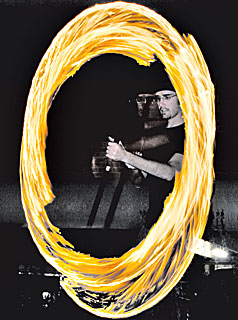 |
|
Photos by Jake Lacey/Arizona Daily Wildcat
|
Undeclared freshman Dan Colecchia. The Street Performance and Incendiary Arts Club gathers every Sunday night to spin fire and dance to music on the Arizona Stage just south of the Second Street Parking Garage.
|
|
|
By Susan Bonicillo
Arizona Daily Wildcat
Tuesday, December 6, 2005
Print this
Fire twirling, sword swallowing on club's weekly agenda
There's a little pyromaniac in all of us. Blame our caveman instincts, but our fascination with this force of nature - both destructive and life-sustaining - starts with childhood, where experiments with a Zippo lighter and your mother's industrial-sized can of hairspray gives you hours of fun and, if you're lucky, a brand-new set of eyebrows.
It continues to adulthood, where fire is contained in metal boxes for use in cooking large pieces of red meat and at times tempting fate by seeing how much lighter fluid you can add until you form a small mushroom cloud hovering over your backyard.
Basic human instincts show that we all like to play with fire. Some of us are just more organized than others.
Take for example the members of the Associated Students of the University of Arizona-recognized club called Street Performance and Incendiary Arts.
On any given Sunday evening, you can find them by the Arizona Stage just south of the Second Street Parking Garage, spinning flaming objects dangerously near vital body parts. The practices can last for several hours. Singed hair and clothing is a risk that all members take into consideration, and even the most experienced among them can accidentally find themselves aflame.
Comprising alumni and current UA students, the group is open to people of all skill levels.
However, the group is not limited to fire-dancing performances. True to their name, SPIA also conducts lessons in proper belly dancing, juggling, sword swallowing (with and without fire) and other street performance arts. Yet the impressive use of fire is what usually draws in their audience and members.
Fire dancing can take a variety of forms. Staff work can either involve using a single wooden pole or two wooden poles with both ends afire.
Another manifestation lies in the use of poi balls.
A particularly impressive part of their performance repertoire, the poi consists of two balls attached to metal chains that the performer uses to spin around their bodies. Maneuvers include figure eights and possible fertility-ending stunts where the poi weaves in and out through the performer's legs.
Dousing the poi in gasoline, the performer goes through a series of tricks until the poi extinguishes after its fuel is depleted.
The use of poi originated on the island nation of New Zealand. The Maoris, the indigenous people of New Zealand, used poi (which means ball on a cord) to train their warriors. The spinning movements were meant to make the wrists and arms properly warmed up and loosened before going into battle.
For poi's contemporary use, the motivations are slightly different.
Originally, it was the offer of martial arts training in use of the staff that hooked Club Treasurer Gary Russo, a senior majoring in biochemistry and molecular biophysics, on the club.
A member of the group since February, Russo joined mainly because learning staff was something he has always wanted to do. However, Russo has since branched out to learning poi, as well.
The learning curve can be discouraging at times.
"Like any other sport, you run into plateaus and you think you're learning nothing," Russo said. "It takes a while before you can continue to advance, where you get to a point where you are learning - but in reality you've been learning all along."
